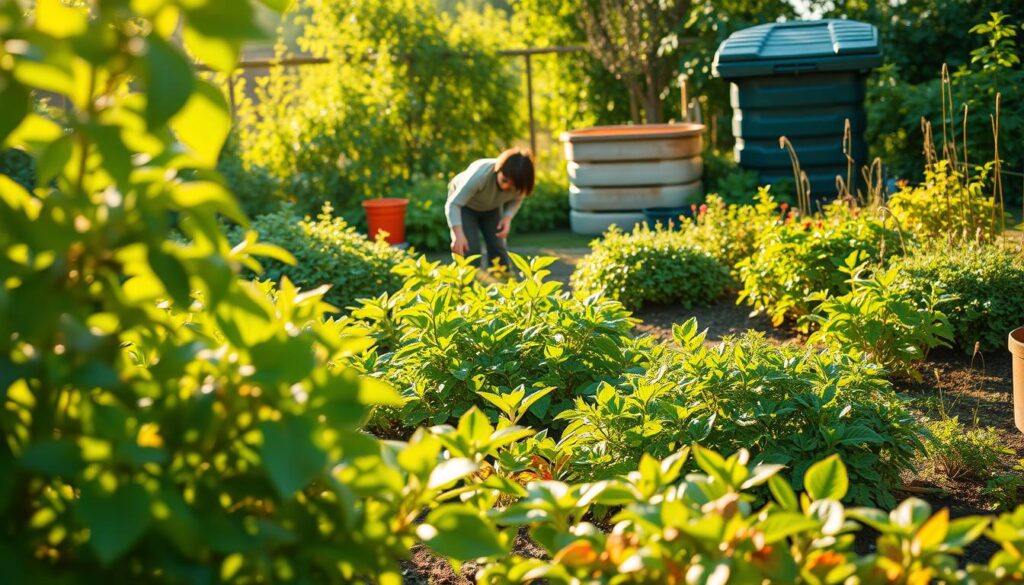Managing plant pests well is key for a healthy garden. Gardeners face many pests like weeds, diseases, and bugs. These pests can really harm plant health if not tackled right.

Seek App
Using Integrated Pest Management (IPM) helps control these issues in a balanced way. It helps keep your plants strong. By following good gardening methods and pest control advice, you can keep pest damage low and your garden healthy.
Anúncios
Understanding the Ecosystem of Your Garden
Your garden is like a bustling city, full of life and interactions. It’s a place where plants, bugs, mushrooms, and animals all connect. They form a complex web that keeps your garden healthy. Knowing the difference between helpful and harmful insects is key to a great garden.
Interactions Between Various Organisms
The garden is alive with different creatures living together. They all play a part in which plants grow well and which don’t. Some insects eat plants which can be bad. But, others, like earthworms and tiny unseen life, help make the soil rich. This is good for plants. Knowing these connections helps gardeners make a peaceful space where plants can flourish.
Anúncios
The Role of Beneficial Insects
Good bugs, like ladybugs and helpful wasps, keep the bad bug numbers down. They go after pests that harm plants. This means less need for chemicals. They also help plants by pollinating them. Making a varied garden space invites these heroes. This creates a healthy garden, making your gardening work a success.
Identifying Common Plant Pests
Knowing about harmful insects is key for protecting your garden. Recognizing these pests allows you to act quickly. It’s also vital to notice signs of bugs to keep your garden healthy.
Types of Harmful Insects
Many insects can hurt your garden. Here are some common ones:
- Aphids – Small bugs that suck on plants, causing them to wilt and leaves to turn yellow.
- Caterpillars – Moth and butterfly babies that eat leaves, causing a lot of damage.
- Beetles – Different kinds can chew and bore into plants, harming them.
Signs of a Pest Infestation
Finding pests early can stop more damage. Here’s what to look for:
- Wilting leaves show stress or sap loss.
- Little holes in leaves mean insects are chewing through them.
- Discoloration or spots on leaves can mean diseases from pests.
How Plant Pests Cause Damage
Learning how pests harm plants is key for good gardening and fighting pests. These pests can cause damage in many ways, hurting plants and spreading diseases. Knowing about these problems helps us protect our plants better.
Physical Damage to Plants
Caterpillars and beetles eat leaves, leaving holes and marks. This damage slows down growth and reduces the plant’s ability to make food from sunlight. Aphids and whiteflies suck out plant juice, making plants weak and poorly nourished. This makes it hard for plants to heal, lowering their overall health.
Transmission of Plant Diseases
Pests don’t just hurt plants physically; they also spread diseases. Bugs like aphids carry diseases that can infect healthy plants. For instance, aphids spread viruses, making it harder to manage pests. Knowing about these dangers is vital for gardeners who want to keep their plants safe from seen and unseen threats.
Pest Management Strategies
Pest management is key to keeping a garden healthy. An important method is Integrated Pest Management (IPM). IPM uses a careful approach to tackle pests by looking at the whole ecosystem. It focuses on sustainable ways like identifying pests, monitoring them, and using both prevention and control strategies.
Overview of Integrated Pest Management (IPM)
IPM combines different strategies to lower damage and cut down on chemicals. It involves:
- Figuring out what pests are present and how they live.
- Checking pest levels to know when to take action.
- Using methods like biological, cultural, and chemical controls that work with nature.
- Supporting good insects and creatures that help fight pests.
Benefits of an Ecosystem Approach
Using an ecosystem method highlights the value of natural garden interactions. By making a balanced environment, gardeners gain benefits such as:
- Less pests, thanks to natural enemies.
- Fewer chemicals used, which is better for the planet.
- Healthier soil and stronger plants from diverse gardening methods.
- A lasting solution as ecosystems grow and aid in pest management.
Prevention Tips for Avoiding Plant Pests
Keeping your garden healthy is crucial, and preventing pests is key. Being proactive helps avoid insect invasions. Checking your garden regularly helps catch problems early. This way, gardeners can fix issues before they get worse. Choosing plants that resist pests can also stop infestations.
Importance of Regular Monitoring
It’s important to check your garden often. Inspections help by:
- Early detection of pest activity
- Assessment of plant health
- Informed decisions regarding pest management
Check your garden every week to keep it safe from pests. Look for unusual signs like weird colors or damage that could mean pests are around.
Using Pest-Resistant Plant Varieties
Choosing plants that pests don’t like can really protect your garden. These plants have special traits that repel pests or handle damage really well. Think about adding these:
- Marigolds: A flower known to repel nematodes and aphids.
- Lavender: Provides a pleasant aroma while keeping pests at bay.
- Zinnias: Attractive to beneficial insects rather than harmful ones.
Using these plants makes it less likely for pests to bother your garden. This makes your pest prevention work even better.
Controlling Plant Pests: Cultural Methods
Cultural pest control is key in keeping plants healthy and lowering the number of pests. By using certain gardening practices, we can make an area that helps plants thrive while keeping pests away. There are two important ways to do this: helping plants stay healthy with good habits and changing what we plant each time to stop pests.
Cultural Practices for Healthy Plants
To get healthy plants, adopting the right cultural practices is vital. These methods boost the strength of plants and defend them from pests. Look at these ways to help:
- Keep soil healthy with tests and needed changes.
- Water properly to avoid too much or too little water.
- Use mulch to keep moisture and keep weeds away.
- Make sure plants get enough sunlight for making food.
Crop Rotation and Plant Diversity
Changing what you plant each time is a smart move in fighting pests. It messes up the pests’ life cycle, making it hard for them to come back. Adding a variety of plants also makes your garden’s ecosystem more balanced. Here’s why these methods are beneficial:
- They decrease pests and sicknesses in the soil.
- They make the soil better because of different roots.
- They make plants stronger against tough conditions.

Physical and Mechanical Control Techniques
It’s vital to use effective physical ways to control pests for a healthy garden. Mechanical methods reduce pests and support eco-friendly gardening. Let’s look at using row covers and traps and the role of weeding and soil care.
Using Row Covers and Traps
Row covers act like a shield for plants against bad insects, letting in light, air, and water. They’re great for keeping young plants safe. Traps can catch harmful bugs and track pest levels, making it easier to keep pests under control.
- Choose lightweight, breathable fabric for row covers to prevent overheating.
- Position traps near plants that show signs of pest activity for optimal results.
- Regularly inspect and adjust row covers and traps to maintain effectiveness.
Weeding and Cultivating Best Practices
Keeping garden beds weed-free is key to controlling pests. Weeds can attract pests and take resources from your plants. Stirring the soil messes up pests’ homes and helps plants grow strong.
- Implement a regular weeding schedule to keep control over unwanted plants.
- Use mechanical methods, such as hoes or tillers, for effective soil cultivation.
- Consider rotating crops annually to prevent pest populations from building up in the soil.
Biological Control Options
Biological pest control is a great way to handle unwanted pests without using harsh chemicals. By using nature’s own methods, gardeners can balance their ecosystem. This not only fights off pests but also helps the garden stay healthy and green.
Utilizing Natural Predators
Natural predators keep pest numbers low. Creatures like ladybugs, lacewings, and predatory mites hunt pests such as aphids and spider mites. Adding these predators to your garden can lessen the need for chemicals.
Having a variety of plants attracts these helpful bugs. This makes your garden a self-regulating environment against pests.
Releasing Beneficial Insects
Another method is releasing helpful insects on purpose. Parasitic wasps, which target pests, are a good example. They manage pests without damaging your plants or the good insects.
Gardeners can buy these insects to improve their garden’s health. Once these insects make a home in your garden, they help build a stronger, healthier environment.
Chemical Pest Control: When to Use
Gardeners often deal with pests that harm their plants. Sometimes, chemical pest control is the only option left. It’s important to know the difference between organic and synthetic pesticides. This knowledge helps reduce risks to plants and the environment.
Understanding Organic vs. Synthetic Pesticides
Organic pesticides come from natural sources and are eco-friendly. They are safer for helpful creatures and break down faster in nature. Synthetic pesticides are made from chemicals and act fast. However, they can harm other species and lead to pesticide resistance if used too much.
Responsible Application Practices
Using pesticides safely is crucial, no matter their origin. Following best practices helps avoid harmful effects.
- Follow label instructions carefully to ensure appropriate dosage and application methods.
- Avoid applying pesticides during windy conditions to minimize drift.
- Implement targeted applications, focusing on affected areas only.
- Consider timing applications based on pest life cycles for maximum effectiveness.
Using chemical pest control wisely helps gardeners keep plants safe. It also protects the ecosystem’s health.
Conclusion
Managing pests in your garden is key for your plants’ health and your garden’s life. To keep your garden healthy, mix different pest control methods. This includes natural and sometimes chemical ways if needed. This mix helps plants grow strong and keeps bugs that cause harm away.
Learning about your garden’s world teaches you how to handle pests better. Check your garden often and choose strong plants. These steps make your garden last and do well. Using many ways to stop pests helps now and in the future. It keeps your garden safe from bugs coming back.
Your hard work in pest management means your garden will bloom and give lots of food. By staying ahead and using smart tactics, you fight off pests. Your garden will flourish, giving joy and crops for a long time.
FAQ
What is Integrated Pest Management (IPM) and why is it important?
How do I identify harmful and beneficial insects in my garden?
What are the signs of a pest infestation I should look for?
What types of damage can plant pests cause?
How can I prevent plant pests in my garden?
What cultural methods can I use to control pest populations?
What physical and mechanical control techniques can I apply?
How can I encourage beneficial insects in my garden for biological control?
When should I consider using chemical pest control options?
Content created with the help of Artificial Intelligence.



